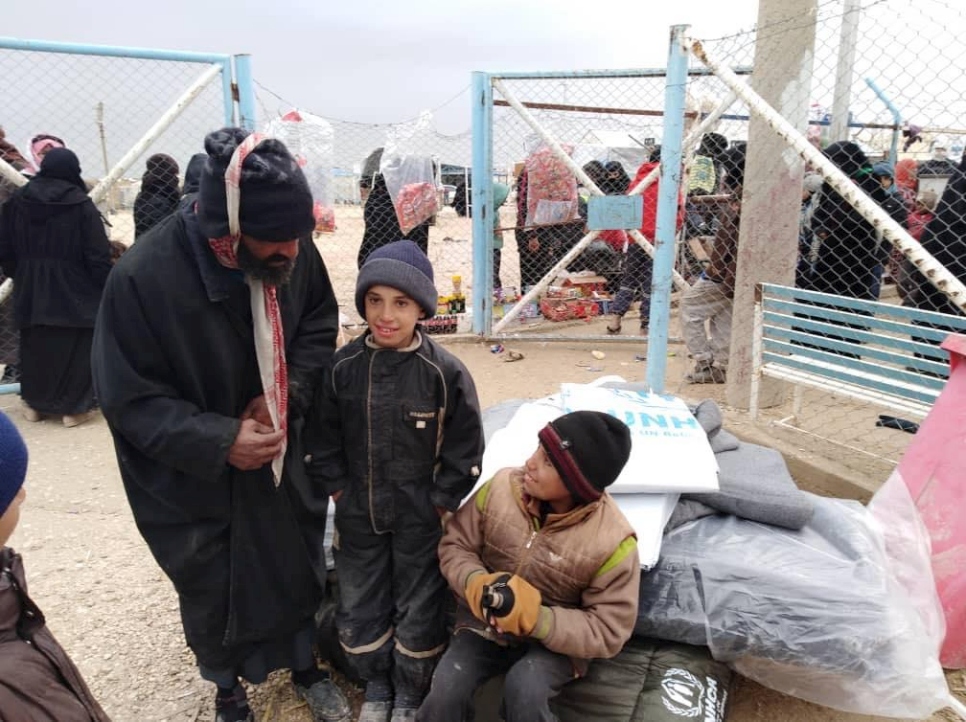Thousands fleeing fighting in northeast Syria – UNHCR
This is a summary of what was said by UNHCR spokesperson Andrej Mahecic – to whom quoted text may be attributed – at today's press briefing at the Palais des Nations in Geneva.

Syrian families wait to receive shelter and relief items at the Al Hol camp in Hassakeh. © UNHCR/Hisham Arafat
UNHCR, the UN Refugee Agency, is deeply concerned by reports of mounting civilian casualties – including many women and children – and large-scale civilian displacement amid renewed fighting in the Hajin enclave in Deir-ez-Zor governorate in the east of Syria. Over the past six months, clashes and airstrikes in southeast part of the governorate forced about 25,000 people to flee.
As well as the women and children, many elderly people are at risk.
It’s estimated that 2,000 people remain in the conflict-affected area of Hajin. Those fleeing report increasingly desperate conditions, with diminishing services and extremely high prices for basic foods. We are worried for civilians who continue to be trapped in ISIS-held areas.
Displaced families reaching the Al Hol camp in northeastern Syria tell our staff that civilians attempting to flee face difficulties and obstacles in leaving the conflict zone. UNHCR calls on all parties, and those with influence over them, to ensure freedom of movement and safe passage.
The majority of the recently displaced have sought shelter at Al Hol camp. There, more than 8,500 individuals have arrived over the past five weeks. Some of the displaced are also staying at the Abu Khashab informal settlement or among local communities. Many are exhausted, having fled on foot, and are clearly suffering. Some have spent four nights or more in the open desert, in heavy rain and in cold weather with barely any belongings, food or water. The dangerous and difficult journey and the conditions inside the enclave are reported to have led to the deaths of six children – all under 12 months. Tragically, most have died after arriving at Al Hol, too weakened to survive.
Emergency health teams in Al Hol are conducting immediate screening and referrals on the spot. Dealing with wounds, amputated limbs, injuries and frostbites is the priority. Acute respiratory infections, cold and flu are also concerns. People are confused, exhausted and distressed, not least because of having left family members behind.
UNHCR and partners are on the ground every day to identify needs and provide protection assistance, especially to unaccompanied or separated children and those who require medical assistance. Our teams distribute tents, core relief items and winter assistance to all newly arrivals. We are preparing new tent plots and scaling up communal facilities in Al Hol for an expected increase of arrivals from Hajin.
We reiterate our calls for unhindered humanitarian access to be able to deliver life-saving humanitarian assistance during this harsh winter period.
In Hassakeh governorate, Al-Areesha makeshift settlement, work on sheltering more than 9,600 displaced people, has been affected by the rapidly rising water in the nearby reservoir. More than two thirds of the camp is under water. Residents are relocating to higher areas of the camp. Humanitarian workers and volunteers have relocated more than 1,200 tents to higher and safer grounds and assembled large communal tents in case the water level increases and more families need to move. Families are frustrated as many have had to move more than once in the last month as the water level continues to rise.
UNHCR and other humanitarian actors are preparing the ground in other camps for possible safe relocation, in case families decide to move.
Meanwhile in Lebanon, Storm Norma has wreaked havoc among Lebanese and refugee communities this week. Several days of strong winds, heavy rain and snow have led to flooding and damage in towns and villages across Lebanon, which is host to nearly one million Syrian refugees. More than 360 sites hosting 11,300 refugees have been affected across the country.
In Minieh, northern Lebanon, the storm took the life of Fatima, an eight-year-old Syrian refugee girl who was swept away by floods. We are supporting her parents and siblings in this very difficult time. Most of the destruction was caused by heavy rain and floods in makeshift sites. In the Bekaa valley alone, at least 600 Syrian refugees have had to relocate due to floods or severe damage to their shelters.
Across Lebanon, UNHCR is assisting 166,000 vulnerable families as part of its winter assistance programme to help them keep warm and dry. Support includes plastic sheeting and wood to help refugees protect their shelters from the elements, as well as a monthly cash assistance of US$75 per family during five cold months, to help families cover additional expenses during winter, including fuel for heating, medicine, and clothes.
This winter, UNHCR aims to provide winterization assistance to 3.5 million vulnerable Syrian and Iraqi internally displaced persons (IDPs) and refugees in Syria, Lebanon, Jordan, Iraq and Egypt. More than two million Syrian and Iraqi IDPs and refugees have been reached with winterization assistance.
UNHCR’s winterization strategy includes provision of seasonal cash assistance for vulnerable families and core relief items specific to cold season as well as preparation of shelters for winter such as weather-proofing and repairs, and improvements to drainage systems and other infrastructure in camps and informal settlements.
The total budget for the Regional Winterization Plan is USD180 million and covers the period from September 2018 to March 2019.
For more information on this topic, please contact:
- In Syria, Mysa Khalaf, [email protected], +963 9933 57860
- In Beirut, Lisa Abou Khaled, [email protected], +961 71 880 070
- In Amman, Rula Amin, [email protected], +962 (0)790 04 58 49
- In Geneva, Andrej Mahecic, [email protected], +41 79 642 97 09
